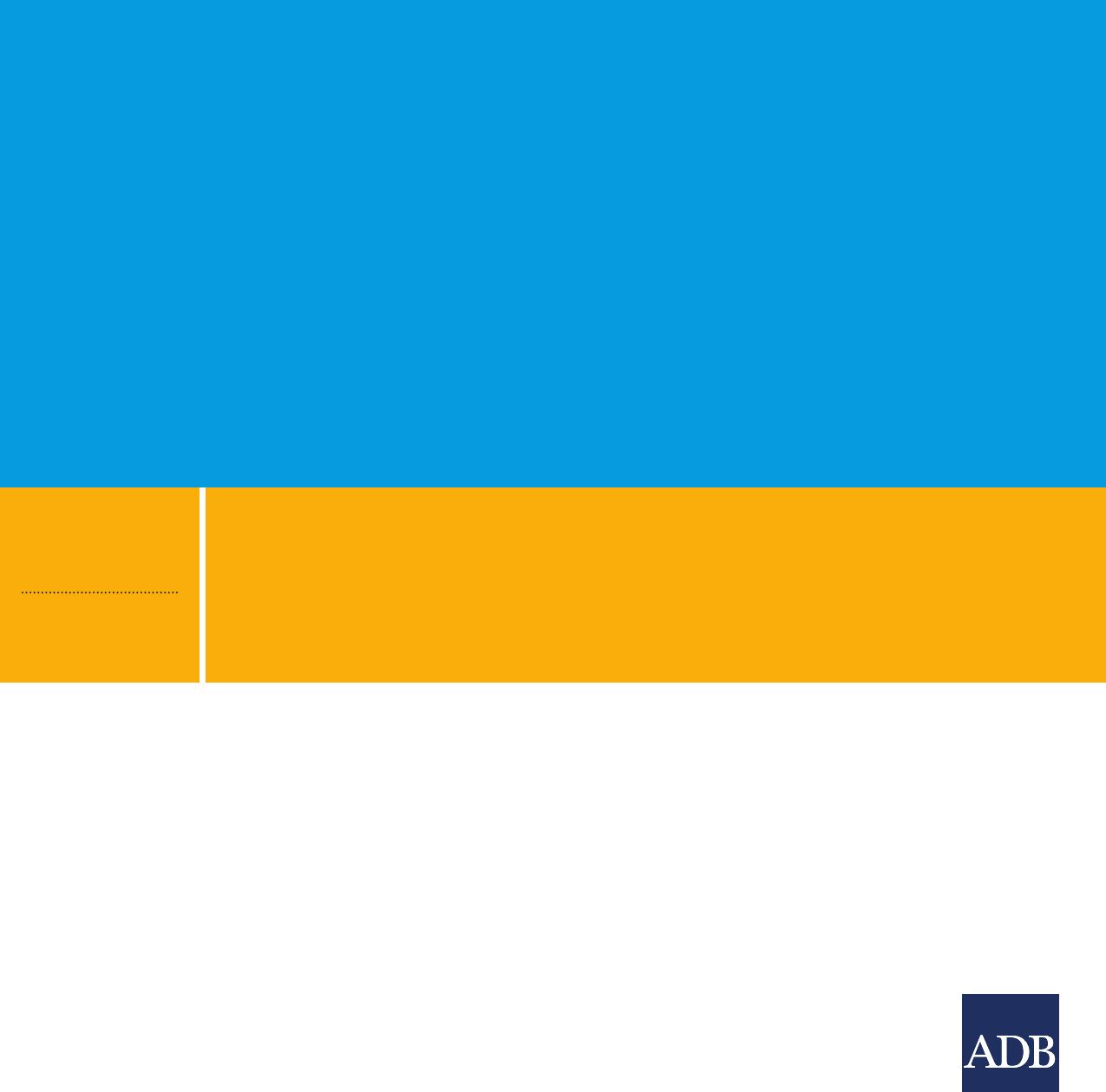ASIA’STRANSITIONTONETZEROOPPORTUNITIESANDCHALLENGESINAGRICULTUREArchiteshPandaandTakashiYamanoNO.694ADBECONOMICSWORKINGPAPERSERIESSeptember2023ASIANDEVELOPMENTBANKADBEconomicsWorkingPaperSeriesAsia’sTransitiontoNetZero:OpportunitiesandChallengesinAgricultureArchiteshPandaandTakashiYamanoArchiteshPanda(panda@ehs.unu.edu)isaseniorNo.694September2023researchassociateattheInstituteforEnvironmentandHumanSecurity,UnitedNationsUniversity.TakashiTheADBEconomicsWorkingPaperSeriesYamano(tyamano@adb.org)isaprincipaleconomistpresentsresearchinprogresstoelicitcommentsattheEconomicResearchandDevelopmentImpactandencouragedebateondevelopmentissuesDepartment,AsianDevelopmentBank.inAsiaandthePacific.TheviewsexpressedarethoseoftheauthorsanddonotnecessarilyreflecttheviewsandpoliciesofADBoritsBoardofGovernorsorthegovernmentstheyrepresent.ASIANDEVELOPMENTBANKCreativeCommonsAttribution3.0IGOlicense(CCBY3.0IGO)©2023AsianDevelopmentBank6ADBAvenue,MandaluyongCity,1550MetroManila,PhilippinesTel+63286324444;Fax+63286362444www.adb.orgSomerightsreserved.Publishedin2023.ISSN2313-6537(print),2313-6545(electronic)PublicationStockNo.WPS230360-2DOI:http://dx.doi.org/10.22617/WPS230360-2TheviewsexpressedinthispublicationarethoseoftheauthorsanddonotnecessarilyreflecttheviewsandpoliciesoftheAsianDevelopmentBank(ADB)oritsBoardofGovernorsorthegovernmentstheyrepresent.ADBdoesnotguaranteetheaccuracyofthedataincludedinthispublicationandacceptsnoresponsibilityforanyconsequenceoftheiruse.ThementionofspecificcompaniesorproductsofmanufacturersdoesnotimplythattheyareendorsedorrecommendedbyADBinpreferencetoothersofasimilarnaturethatarenotmentioned.Bymakinganydesignationoforreferencetoaparticularterritoryorgeographicarea,orbyusingtheterm“country”inthispublication,ADBdoesnotintendtomakeanyjudgmentsastothelegalorotherstatusofanyterritoryorarea.ThispublicationisavailableundertheCreativeCommonsAttribution3.0IGOlicense(CCBY3.0IGO)https://creativecommons.org/licenses/by/3.0/igo/.Byusingthecontentofthispublication,youagreetobeboundbythetermsofthislicense.Forattribution,translations,adaptations,andpermissions,pleasereadtheprovisionsandtermsofuseathttps://www.adb.org/terms-use#openaccess.ThisCClicensedoesnotapplytonon-ADBcopyrightmaterialsinthispublication.Ifthematerialisattributedtoanothersource,pleasecontactthecopyrightownerorpublisherofthatsourceforpermissiontoreproduceit.ADBcannotbeheldliableforanyclaimsthatariseasaresultofyouruseofthematerial.Pleasecontactpubsmarketing@adb.orgifyouhavequestionsorcommentswithrespecttocontent,orifyouwishtoobtaincopyrightpermissionforyourintendedusethatdoesnotfallwithintheseterms,orforpermissiontousetheADBlogo.CorrigendatoADBpublicationsmaybefoundathttp://www.adb.org/publications/corrigenda.Note:Inthispublication,“$”referstoUnitedStatesdollars.ABSTRACTAsiaishometo60%oftheworld'spopulation,52%ofglobalagriculturalproduction,and43%ofagriculture-relatedgreenhousegas(GHG)emissions.WhilealargeportionoftheAsianpopulationdependsonagriculturefortheirlivelihoodandfoodsecurity,theagriculturesectorisoneofthemainsourcesofGHGemissionsintheregion.InsomeAsianeconomies,itaccountsformorethan40%oftotalemissions.ThisreportidentifiesthemajorsourcesofGHGemissionsfromtheagriculturesectorandreviewsavarietyoftoolsandtechnologiestochangeemissionpathways.Italsodiscussestheinstitutional,political,andeconomicchallengesforachievingprogresstowardacost-effective,inclusive,andresilienttransitiontonet-zeroagriculture.Keywords:climatechange,net-zeroagriculture,AsiaandthePacific,non-carbondioxideequivalent,non-CO2eJELcodes:Q01,Q1,Q54_______________AnearlierversionofthispaperisusedasabackgroundpaperintheAsianDevelopmentOutlook2023ThematicReport:AsiaintheGlobalTransitiontoNetZeroavailableathttp://dx.doi.org/10.22617/FLS230135-2.I.INTRODUCTIONTheagriculture,forestry,andotherlanduse(AFOLU)sectorcontributesabout22%(13gigatonsofcarbondioxideequivalent[GtCO2e])ofnetglobalgreenhousegas(GHG)emissionsin2019andcanplayanimportantroleinachievingclimatechangemitigationtargetsduetosubstantialmitigationpotentialoptionsinthesector(IPCC2023).TheAFOLUsectorcanprovide20%–30%oftheglobalmitigationneededtoachievethe1.5°Cor2°Cpathwayby2050(IPCC2022a).AFOLUactivitiescontributedabout13%ofcarbondioxide(CO2)globallybetween2007and2016,whilemethane(CH4)andnitrousoxide(N2O)emissionsfromhumanactivitiesaccountedfor44%and81%,respectively(IPCC2019).RecentevidencesuggeststhatagriculturalCH4emissionscontinuetoincrease,withentericfermentationandricecultivationremainingthemainsourcesofemissionsbetween1990and2019(IPCC2022b).In2018,globalemissionsfromagriculture(withinthefarmgateandincludingassociatedlanduseand/orland-usechange)totaled9.3billiontonsofCO2equivalent(CO2e).Ofthetotalemissionsin2018,CH4andN2Oemissionsfromcropandlivestockactivitiesaccountedfor5.3billiontonsofCO2e,livestockproductionprocessesgenerated3billiontonsofCO2e,andemissionsfromlanduseandland-usechangeaccountedfor4billiontonsofCO2e(FAO2020a).TheIntergovernmentalPanelonClimateChange(IPCC)SpecialReportonGlobalWarmingof1.5°Chighlightstheimportanceofachievingnet‐zeroglobalemissionsofCO2bymid‐centuryorsoonertoavoidtheworsteffectsofclimatechange(IPCC2018).Achievingnet-zeroGHGemissionsprimarilyrequiresdeepcutsinCO2,CH4,andotherGHGemissions,andimpliesnet-negativeCO2emissions.Topreventglobalwarmingfromexceeding1.5°C,emissionsneedtobereducedby45%by2030andreachnetzeroby2050(UN2022).AggregatingCH4andN2OtoCO2equivalents(usingIPCCAR6GWP100values)impliesthatAFOLUemissionsescalatedby15%globallybetween1990and2019(IPCC2022b).Asfarasagricultureisconcerned,Asianeconomies1occupyanimportantplaceintheglobalscenario.Thesectorprovidedlivelihoodsformorethan563millionpeoplein2021andoftencharacterizedbylowincomes,lowskillscomposition,difficultworkingconditions,andhighrisksassociatedwithagriculturalactivities,particularlyforsmallholderfarmers(ILO2022).Despitesignificanteconomicprogressoverthepastdecade,thecoronavirusdisease(COVID-1AsiainthispaperreferstoAsianDevelopmentBank(ADB)membersintheAsiaandPacificregion,unlessotherwisestated.219)pandemichaspushedabout78millionpeopleinAsiabackintoextremepovertyandcreatedanother162millionpoor,particularlyinSouthAsia(ADB2021a).Climatechangevulnerabilityanddisastersareagrowingconcernintheregion.Atthesametime,AsiaisalsoamajorcontributorofGHGemissionsfromagriculture.Achievingnet-zeroagricultureinAsiawillbeamajorchallenge,requiringsignificantreductionsinemissionsfromagricultureandtransformativechangesinfood,livestock,anddietarypatterns.ClimateactioninAsiacanhaveahugepositiveimpactonreducingglobalGHGemissionsifappropriateandnecessarystepsaretaken.II.BACKGROUNDTheterm“net-zeroemissions”meansabalancebetweenthecurrentanthropogenicreleaseofGHGsintotheatmosphereandtheactiveremovalofgreenhousegasesoveragivenperiod.Ingeneralterms,thismeansasituationinwhichhuman-inducedcarbonflowsintoandoutoftheatmospherearebalancedandtemperaturestabilizestemporarilyorsustainably(Allenetal.2022).Toachievenet-zeroemissions,negativenetCO2emissionsarerequiredtooffsettheremainingCH4,N2O,andF-gasemissions.Agriculture,landuse,andforestryplayasignificantroleinachievingnet-zeroemissionsbyreducingcarbon,CH4,andN2Oemissionswhileprotectingourfoodsupplyandotherlandresources.Emissionsfromagriculturewillbecomemoreimportantasemissionsfromenergyandindustrialprocessesdeclineinthetransitiontonet-zeroemissions(IPCC2018).AgriculturecontributestoGHGemissionsinfourways:land-usechange,agriculturalactivities,livestock,andfoodproduction.Agriculturalactivitiesemitseveralnon-CO2GHGs.Methaneandnitrousoxidearethemostcommonfarm-relatedemissions,contributingtoabout65%ofagriculturalemissionsglobally(Searchingeretal.2019).ThelargestsourcesofCH4emissionscomefromcattlebelching,whileN2Ocomesfromnitrogendepositioninland-basedagriculture,primarilyduetouseofsyntheticfertilizersormanurewasteinsoils.Comparedtoothercountries,AFOLUemissionsaregenerallyhigherindevelopingcountries.In2019,severalregionsinAsia—EastAsia,SouthAsia,andSoutheastAsia—accountedfor9%,10%,and22%oftotalabsoluteAFOLUGHGemissions,respectively.SoutheastAsiahadthehighestAFOLUGHGpercapitaemissionsinAsia(IPCC2022b).TheAsiahasacollectivecommitmenttoreduceanestimated13.5GtCO2eofGHGemissions,or32%oftheestimatedregionalGHGemissionstotaling42.7GtCO2e,by2030undercurrentclimatepoliciestomeetthe1.5°Ctarget(UNESCAP3etal.2021).TheIPCChasrecommendedrequiredGHGemissionsby2030forAsia,estimatingthemtobeabout9.8GtCO2e(IPCC2021).Duetohighpopulationdensity,highpovertylevels,andheavyrelianceonagricultureandnaturalresources,millionsofpeopleinAsiastillsufferfromfoodinsecurity,makingthemmorevulnerabletotheimpactsofclimatechange.ThroughNationallyDeterminedContributions(NDCs),countriescommittoreducingtheirGHGemissionstoachievethenet-zerotarget.Currently,49members2inAsiahavesubmittedtheirintendedNDCs,ofwhich46havebecomeNDCs.EvidencesuggeststhattheNDCsneedtobesignificantlyimprovedtoachievecarbonneutralityin2050–2060.Iftheseunconditionalandconditionalcommitmentsareputintoeffectby2030,GHGemissionswoulddecreasebyonly8%,whichistoolowtoachievenet-zeroCO2eby2050(UNESCAPetal.2021).WhileNDCsandoverallemissionreductiontargetsarecontinuouslybeingupdatedinAsia,eacheconomyisdifferent,andemissionreductionsintheseeconomiesmayoccurthroughdifferentchannels,sodifferentmeasuresmayberequiredtobringemissionsintheagriculturesectortonetzero.A.StatusofAgriculturalEmissionsinAsiaIn2018,totalemissionsfromagricultureandrelatedlanduseworldwidereached9.3billionGtCO2e.InAsia,emissionsfromagriculturalactivitiesamountedto3.3GtCO2eoverthesameperiod,representingnearlyone-thirdoftheglobalshareofemissionsfromagriculture(FAO2020a).AsiahasthehighestshareofglobalAFOLUemissions,mainlyduetodeforestationandagriculturalemissions.Underthebusiness-as-usualscenario,globalCO2eemissionsfromagriculturalproductionareprojectedtoincreasefrom6.8GtCO2eperyearin2010to9.0GtCO2eperyearin2050andfromabout12GtCO2eperyearin2010to15GtCO2eperyearby2050foragricultureandland-usechange,respectively(Searchingeretal.2019).B.DriversofAgriculturalandLand-UseEmissionsinAsiaAsiacomprisesmanysmallandlargeeconomieswithdifferentcharacteristicsofagricultureandland-usechange.Ontheonehand,therearetheworld’slargestagriculturalemitterssuchasIndiaandthePeople’sRepublicofChina(PRC),eachwithabout650milliontonsofCO2eannualemissionsin2018,butontheotherhand,therearecarbon-negative2DefinedasUNESCAPmembersandassociatemembersintheAsiaandPacificregion.4countriessuchasBhutan.MostoftheGHGemissionsfromtheglobalfoodsystemcomefromfoodproductionandlandclearingforfoodproduction.About80%oftheopportunitiestomitigateclimatechangeinthelandsectoroverthenextdecadecomefromtransformingfoodsystemsandavoidingtheassociateddeforestationby2030(ConservationInternational2022).Intermsoftotalabsoluteemissions,thePRC,India,Pakistan,andIndonesiaareamongthelargestemitters(Figure1).DatafromvariousstudiesonagriculturalemissionsfromAsiarevealthefollowingtrendsandpatterns:(i)ThemajorsourcesofagriculturalemissionsinAsiaarericecultivation,syntheticfertilizeruse,cropresidueburning,andmanuremanagement.Inmostcases,themajorityofemissionscomefromafewcountriessuchasIndia,Indonesia,Pakistan,thePhilippines,thePRC,andVietNam(seeFigure2).EvidenceshowsthatAsiahasthelargestshare(37%)ofemissionsfromentericfermentationandmanuremanagementsince2000(IPCC2022b).(ii)Asiadominatesglobalriceproduction,withSoutheastAsiaandthePacificregionmainlyresponsiblefor89%ofemissionsfromricecultivation,whichhavebeenincreasingsince2010(IPCC2019).Forexample,riceproductionaccountsfor39%oftotalfoodsystememissionsinThailandand40%inBangladesh.Inaddition,emissionsfromenergyconsumptioninAsiahaveincreasedcomparedtothe1990sduetomechanizationoftheagriculturesector.TotalGHGemissionsfromfoodsystemsinAsiahaveincreasedfrom9.8GtCO2ein1990to24GtCO2ein2015(Crippaetal.2021).Irrigatedfloodedrice,whichoccupiesabouthalfofthetotalrice-growingareaandaccountsfor75%ofglobalriceproduction,isamajorsourceofCH4emissions.EmissionreductionstrategiesinthericesectorincludepracticessuchasincreaseduseofCH4-reducingricevarieties(ADB2019;Jiangetal.2017;andKrausetal.2022),ricestrawremoval,alternativewettinganddrying,anddryseeding.(iii)Asiaaccountedfor15%oftheglobalforestareain2020.Agricultureisoneofthemaindriversofland-usechangeleadingtodeforestation.Globalagriculturallandareaincreasedby1%inAsiaandthePacificbetween2000and2019(IPCC52022a).Between2010and2014,therewasanetemissionof2.6GtCO2year-1duetodeforestationassociatedwiththeexpansionofcropland,pasture,andforestplantationsinthetropics(Pendrilletal.2019)(Figure3).InIndonesia,almosthalfoftheemissions(0.3GtCO2year−1)comefromoilseeds(mainlyoilpalm)andpeatlanddrainage(0.3–0.4GtCO2year−1).(iv)TheuseofsyntheticfertilizershasbeenidentifiedasamajorsourceofglobalN2Oemissions.SouthAsiarecordedthehighestgrowthN2OemissionsfromtheAFOLUsectorbetween1990and2019(Linetal.2021).GrazinglandswerethenotablesourcesofN2OemissionsinEastAsiaandSouthAsia(IPCC2019).Between2000and2010,AsiawasthelargestsourceandhighestgrowthrateofN2Oemissionsfromsyntheticfertilizers,accordingtotheIPCCAR5(IPCC2014).(v)Reductionsinemissionsfromthefoodsystem,whichconsistsofemissionsfromconsumption,production,andfoodwaste,varyacrossAsia.Recentanalysisshowsthatafewcountries,suchasIndia,thePRC,Indonesia,Myanmar,3thePhilippines,andPakistan,areresponsibleforalargeshareoffoodsystememissions(Figure4)becausetheyrequirematerialsandenergyforprocessing,packaging,transportation,andstorage.Fromanemissionsmitigationperspective,thistrendsuggeststhatthefoodsectorrequiresspecificsectoralenergyefficiencyanddecarbonizationpolicies,aswellasemissionsmitigationpoliciesforbothconsumersandproducers(Crippaetal.2021;PooreandNemecek2018).(vi)GHGemissionsfromentericfermentationdominateagriculturalCH4emissionsinAsia.Accordingtorecentestimates,totalemissionsfromlivestockproductioninAsiain2015were2.64billiontonsofCO2e,frommajorsourcessuchasentericfermentation,feed,andmanure(FAO2020b).3ADBplacedonholditsassistanceinMyanmareffective1February2021.ADBStatementonMyanmarAsianDevelopmentBank(publishedon10March2021).Manila.6Figure1:AgriculturalEmissionsbyCountryin2019,ExcludingLand-UseChangeandForestryCountrySharetoCountry’sTotalEmissionsEmissions(MtCO2e)(%)2000200400600800AgriculturalemissionsIndia21.2%PRC5.2%PakistanIndonesia45.0%Bangladesh17.7%MyanmarThailand40.4%Philippines65.2%KazakhstanNepal15.5%Japan25.8%CambodiaMalaysia10.3%SriLanka58.8%PapuaNewGuinea1.9%53.3%4.6%16.0%20.4%MtCO2e=milliontonsofcarbondioxideequivalent,PRC=People’sRepublicofChina.Notes:ADBplacedonholditsassistanceinMyanmareffective1February2021.ADBStatementonMyanmarAsianDevelopmentBank(publishedon10March2021).Manila.Source:FAO(2020b).7Figure2:TotalAgriculturalEmissionsbyCountry,1990–2020CO2e=carbondioxideequivalent,LaoPDR=LaoPeople’sDemocraticRepublic,PRC=People’sRepublicofChina.Note:ADBplacedonholditsassistanceinMyanmareffective1February2021.ADBStatementonMyanmarAsianDevelopmentBank(publishedon10March2021).Manila.Source:FAO(2022b).8Figure3:AverageForestLossAttributedtotheExpansionofCropland,Pasture,orPlantationsinAsia,2010–2014(hectare)andEmissions(MtCO2e)CountryCropsPasturesForestPlantationsPeatCarbonEmissionForestCarbonForestLossRestoftheWorld5001,0001,5002,0002,5003,0003,5004,000RestofAsiaIndonesia50100150200250300350India02004006008001,0001,2001,4001,600RestoftheWorldRestofAsiaIndonesiaIndia0RestoftheWorldRestofAsiaIndonesiaIndia0MtCO2e=milliontonsofcarbondioxideequivalent.Source:BasedondatafromPendrilletal.(2019).9Figure4:EmissionsfromFoodSystemsinAsia,2015(MtCO2e)GWP_100_CH4GWP_100_CO2ConsPRC28ConsPRCIndia7IndiaIndonesia3IndonesiaPakistan2PakistanVietNam1Kazakhstan010203004080120EndPRCEndPRCIndiaIndonesiaIndonesiaPakistanBangladesh1002003000.00.30.60.9VietNamPhilippines0PackPRCPackPRCIndonesiaIndiaKorea,RepublicofIndiaPakistanMalaysiaPakistan1020300150300450Proc0ProcPRCIndiaPRCKorea,RepublicofIndonesiaIndonesiaIndia102030060120180PakistanProdKazakhstanProdPRCPhilippinesIndia250500750Indonesia1002003000KazakhstanPRC0IndiaPakistanIndonesiaBangladeshMyanmarPhilippines0RetaiPRCRetaiPRCIndiaIndiaUzbekistanIndonesiaIndonesiaKazakhstan01230204060TranPRCTranPRCKazakhstanIndiaKorea,RepublicofMalaysiaIndonesiaIndonesiaKazakhstan01230306090CH4=methane,CO2=carbondioxide,cons=consumption,GHG=greenhousegas,IPCC=IntergovernmentalPanelonClimateChange,MtCO2e=milliontonsofcarbondioxideequivalent,N2O=nitrousoxide,Cons=Consumption,Pack=packaging,Pro=production,Proc=processing,End=endoflife,PRC=People’sRepublicofChina,Reta=Retail,Tran=Transportation.Notes:Non-CO2GHGemissions(CH4,N2O)arestatedasCO2ecomputedusingthe100-yearglobalwarmingpotentialvalues(GWP100)adoptedintheIPCCFifthAssessmentReport(AR5).ADBplacedonholditsassistanceinMyanmareffective1February2021.ADBStatementonMyanmarAsianDevelopmentBank(publishedon10March2021).Manila.Source:DatafromCrippaetal.(2021).10C.EmissionsReductionfromLand-UseChangeinAsiaandthePacificThepatternsanddriversofGHGemissionsfromlandmanagementandland-usechange(land-useemissions)inAsiahavenotbeenanalyzedasthoroughlyasthoseofGHGemissionsfromfossilfuels.Thefollowingisasummaryofsomeofthemostimportantfindingsfromthestudiesnowavailableonemissionsfromland-usechangeandthepossibilityofemissionreductioninterventions:(i)Afterfossilfueluse,carbonemissionsfromdeforestationandforestdegradationinthetropicsarethesecond-largestsourceofemissionsworldwide(Sharma,Thapa,andMatin2020).(ii)Commercialagricultureisresponsibleforabout35%ofdeforestationinAsiaandAfrica.AccordingtoGriscometal.(2017),nearly80%ofglobaldeforestationiscausedbyagriculture.Asaresultoftheconversionofforestsandpeatlandstoagriculturalandgrazinglands,countriesinAsiasuchasIndonesiaandIndiaplayasignificantroleinthebuildupofgreenhousegases(Figure3).(iii)From1961to2017,SoutheastAsiahashadsomeofthehighestemissionsfromland-usechange.Land-useemissionsareduetotheexpansionofcroplandsandspikescausedbymoreintensiveland-useconversionasaresultofrapidandextensivegrowthinagriculturalproduction(Hongetal.2021;Smithetal.2019).(iv)Since2001,annualforestcarbonlossintropicalAsiahasincreasedsubstantiallyandsteadily,amountingto43%ofthesurgeinpantropicalcarbonloss.PartsofSoutheastAsiaarehotspotsofforestcarbonloss(Curranetal.2004;Fengetal.2022).(v)WhileSoutheastAsiawasthelargestcontributortoemissionsfromforestdegradationbetween2005and2010,theharvestingoftimberandwoodfuelsisthelargestcontributortoemissionsassociatedwithforestdegradation(Pearsonetal.2017).(vi)SoutheastAsiaisoneoftheregionswiththelargestnumberofnaturalforests.However,arecentstudypredictsadeclineinnaturalforestsfrom213.46million11hectares(ha)in2000to180.70millionhain2030,suggestingadeclineincarbonstocks(Sasakietal.2021).ItisimportantforSoutheastAsiatocommittosustainableforestmanagementtoavoidtheconsequencesofforestresourceloss.ImplementationofREDD+,whichstandsforreducingemissionsfromdeforestationandforestdegradationindevelopingcountries,mechanismscouldresultinnetcarbonrevenuesof$8billion–$180billionbetween2020and2030,dependingonthecarbonprice.(vii)Accordingtorecentstudies,pre-andpost-productionactivitiesaccountedfortheremainingemissionsfromagri-foodactivitiesin2018,makinguponlyabout4%ofglobalgrossdomesticproduct(GDP).Thus,agriculturalproductionandnewlandusedforagriculturalproductiongeneratednearlytwo-thirdsofallemissions.Overthepast60years,309millionhahavebeenusedforagriculture,despiteanincreaseinagriculturallandofonly7%(205millionhaforgrainproductionand104millionhaforcattlepastures).ConversionofforestsforagriculturalusehasthereforehistoricallybeenasignificantsourceofGHGemissions,bringingabout11%ofglobalemissionsbetween2007and2016(Gautametal.2022).(viii)Agricultureisoneofthebiggestdriversofbiodiversitylossandimposeshugeeconomiccoststhroughthelossofecosystemservices(Johnsonetal.2021;Almond,Grooten,andPetersen2020;Prudhomme2020).Therearemanyopportunitiestoreducesectoremissionsandimproveremovalsassociatedwithlanduse,land-usechange,andforestry,includingminimizingdeforestation,increasingafforestation,improvingsustainableforestmanagement,andraisingforestcarbonstocks.Asiaismadeupofemergingeconomieswhereemissionsfromland-usechangeareminimalbutemissionsfromagricultureareincreasingrapidly(EastAsia,SouthAsia,andtheMiddleEast)andcountrieswhereemissionsfromland-usechangearebothsubstantialandincreasing(SoutheastAsia).Forthefirstgroupofcountries,themosteffectivemeansofmitigatingclimatechangeistorestrictland-usechange,particularlytheconversionofcarbon-densetropicalforeststosoy,rice,maize,andoilpalm.Reducedinputefficiency,improvedsoilandlivestockwastemanagement,decreasedfoodwasteorbehavior,andpolicychangesinagriculturaldemandareallwaystoreducetheemissionsintensityofagriculturalproductionforcountriesinthesecondcategory(Hongetal.2021).12Inadditiontoincreasedannualcarbonremovalsintheland-usesector,emissionsreductionisessentialtoachievingthenet-zerogoal.Thisincludesthepossibilityofextensiveuseofbioenergyandlanduseincombinationwithnegativeemissionstechnologies(Box1),4suchascarboncaptureandstorage,andtheuseofvariousnaturalclimatesolutions(NCSs)5likeconservation,restoration,and/orimprovedlandmanagementtechniquesthatpromotecarbonstorageand/orsequestrationofGHGemissionsinglobalforests,wetlands,grasslands,andagriculturallands(Griscometal.2017).Reforestation,avoidedforestconversion,andgrasslandshavethegreatestpotentialreddtocutemissionsamongthevariousNCSpathwaysexaminedtoachieveadrasticreductioninemissions,andtheymeritadditionalconsiderationtofindopportunitiesforcost-effectiveemissionsreductions.Atacostofnomorethan$100pertonofCO2(tCO2),thesesolutionscouldcontribute37%oftheGHGreductionsneededin2030tohavea>66%chanceofavoidinga2°Cincreaseinglobalmeantemperature(Griscometal.2017).Thehighestcarbonstocksperhectarearefoundintropicalforests,peatlands,andmangroves.However,thepotentialforavoidingforestconversionis4–5timesgreaterthanthepotentialforavoidingimpactsonpeatlandsand10–12timesgreaterthanthepotentialforavoidingimpactsoncoastalwetlandssuchasmangroves,saltmarshes,andseagrassbeds(UNEPandIUCN2021).TohelpachievethegoalsoftheParisAgreement,theland-usesectorinAsiaandthePacificofferstremendousopportunitiesforemissionsreductions(seeBoxes2and3).Designinghigh-priorityland-use-basedmitigationpoliciesshouldaimtoreduceGHGemissionsfromlanduseincountrieswithhighemissionsfromland-usechange.4NegativeemissionsarenotaboutthenaturalprocessesofCO2removal.Rather,theyaredefinedasthedeliberateeffortsofhumanstoremoveCO2emissionsfromtheatmosphere(Minxetal.2018).5“Naturalclimatesolutions”(Griscometal.2017)aredescribedasasubsetofnature-basedsolutions(NBS)thatfocusonmitigatingclimatechange.NBSare“actionstoprotect,sustainablymanage,andrestorenaturalormodifiedecosystemsthataddresssocietalchallengeseffectivelyandadaptively,simultaneouslyprovidinghumanwell-beingandbiodiversitybenefits”(IUCN2016).Therearevariationsintheuseandinterpretationofthedefinition(UNEPandIUCN2021).13Box1:AgricultureandtheBioenergyMarketinSoutheastAsiaBioenergyhasthepotentialtobecomethemostimportantenergysourceinSoutheastAsia'sentireenergymix,accountingformorethan40%oftotalprimaryenergysupplyby2050,inaccordancewiththeParisobjectiveof2degreesCelsius(IRENA2022).EvidencesuggeststhatSoutheastAsia'sbioenergysupplyisstilluntapped.Thisholdsthepotentialforanetpresentsocioeconomicvalueof$144billionin2050,aswellasthecreationofmorethan452,000newresilientjobsandthereductionofabout442milliontonnesofcarbondioxideequivalentgreenhousegas(GHG)emissionsperyear.Theagriculturalresidues(palmoil,rice,sugarcane),cassavapulp,rubber,teak,sugarcanemolasses,andacaciageneratedbySoutheastAsia'shighproductivitygeneratesubstantialamountsofunderutilizedresidues.Malaysia,Indonesia,andThailandhavealreadycompletedseveralbioenergyprojectsthatgenerateenergyfromagriculturalproductssuchaspalmoil,sugarcane,corn,cassava,andrice.However,mostoftheattemptsarecurrentlysmallinscaleandthereareconsiderabledifficulties,suchaslegalandinstitutionalbarriers,highcosts,lackofresearchanddevelopment,lackofcommercialfeasibilityofthetechnologies,andlackofregulatoryframeworks.Governmentsintheregionneedtoadopteffectivemeasurestoaddressclimatechange-influencedchanges.Forexample,recentevidencepredictsthattheareasuitableforrubberfarmingintheGreaterMekongSubregioncouldexpandbymorethan50%by2030duetoclimatechange.Similarly,inIndonesia,mostbiomassburningiscausedbyforestclearingforoilpalmagriculture,whichisasubstantialsourceofGHGemissions.Anydecisiontoachievenet-zeroemissionsinAsiamustconsidertheregion'sgrowingconcernsandchallengesrelatedtoland-usechange.Source:IRENA(2022);VardrevuandOhara(2020).14Box2:EmissionsReductionthroughREDD+inAsiaandthePacificReducingemissionsfromdeforestationandforestdegradationandotherrelatedmeasures(REDD+)indevelopingcountriesiscriticaltoachievingthenet-zeroemissionstargetinAsiaandthePacific.ManycountriesinAsiahaveparticipatedintheprocessofnationalREDD+strategy(Ochiengetal.2018).ThroughtheForestCarbonPartnershipFacility(FCPF),somecountrieshavealsoreceivedfundingfromtheFCPFReedinessFundandtheFCPFCarbonFund.TheseincludecountriessuchasFiji,Indonesia,theLaoPeople’sDemocraticRepublic,Nepal,andVietNam(WorldBank2022).OthercountriessuchasThailandandCambodiahaverecentlysubmittedtheirforestreferenceemissionlevelsandarepreparingtoreceivefundingfromcertifiedemissionreductions.Fifty-sixcountrieshaveincludeditintheirIntendedNationallyDeterminedContributionsasaclimatechangemitigationinstrument(Heinetal.2018).However,morethan10yearsafterthelaunchofREDD+,therearestillmanychallengesthatneedtobeaddressedbeforeitbecomesaneffectivemeansofreducingemissionsfromdeforestation.Forexample,REDD+hasnotbeeneffectiveagainsttheimmediatecausesofdeforestation,suchastheexpansionofagricultureforhigh-valuecrops(Andohetal.2022).ThereisanurgentneedtoaddresstheissuesrelatedtothedriversofdeforestationinAsiatoachievetangibleresultsfromtheprocessofREDD+.Sources:WorldBank(2022);Andohetal.(2022);Heinetal.(2018).D.EmissionsReductionPotentialinAsia:AnAssessmentAsiaisoneoftheregionswiththefastest-growingemissionsfromagricultureandland-usechange(Fujimorietal.2022;OECD2019).TheagriculturalindustryoffersavarietyofsolutionstomitigateGHGemissions(Roeetal.2021).Toreachthenet-zerotargetmorequickly,bothconventionalagriculturalemissionsreductiontechniques,suchasfertilizerandwatermanagement,andnegativeemissionstechnologiesmustbeused(Fussetal.2018;Minxetal.2018).Inaddition,itisimportanttorememberthatagriculturecontributestodeforestationandthatpoliciesthataffectland-usechangealsoinfluenceagriculturalmitigationstrategies.The’potentialabatement,benefits,cost-effectiveness,andsideeffectsofthetransitionmustbeconsidered(Eoryetal.2018).Intermsofpolicy,therearealsoconcernsabouthowtoincentivizeandimplementpracticesthatwouldboostagriculturalproductivitygrowthandsustainableresourceuse,andwhethertherewouldbetrade-offswithGHGmitigationandadaptationgoals(Lankoski,Ignaciuk,15andJésus2018).Theavailabilityofdataonglobalemissionsfromtheagriculturesectorlagsbehindthatofdataonfossilfuelemissions,despitegrowinginterestintheabilityoftheagriculturesectortoreduceGHGemissions(Tubielloetal.2013).Thefactthatagricultureisquiteheterogeneousbothspatiallyandtemporallypresentsadditionaldifficulties(Beachetal.2015).Thismakesitnecessarytoconsiderbiophysicalandmanagementconditionsthataffecttheefficiencyandcostofalternativemitigationoptionsatadisaggregatedscale.ToachieveAFOLUemissionreductionsandremovalswithoutjeopardizingglobalfoodsecurity,poverty,economicgrowth,andresilience,technologicaladvancesthatenhancemitigationmustbedevelopedandused.Technologicalsolutionswillenableclimatechangemitigationwhileminimizingnegativeeffectsonfoodproduction.Asiawillsuffersignificanteconomiclossesasaresultofclimatechange.Forexample,theeconomiesoftheAssociationofSoutheastAsianNationswouldlosenearly37%oftheirGDPby2048.AccordingtotheSwissReInstitute(2021),theeconomiesofIndonesia,Malaysia,thePhilippines,Singapore,andThailandwouldlosemorethanseventimestheir2019GDPby2050.Land-basedandagriculture-basedmitigationmeasurescanpotentially6helpachieveclimatechangegoals.Forexample,nature-basedclimatesolutions,includingconservation,restoration,and/orimprovedlandmanagementmeasuresthatavoidGHGemissionsinglobalforests,wetlands,grasslands,andagriculturallands,canprovidemorethanone-thirdofthecost-effectivemitigationneededtokeepwarmingbelow2°Cby2030(Griscometal.2017).However,between2009and2019,mitigationpoliciesandprogramshaveresultedinonlyabout8GtCO2ofmitigationfromAFOLU,orabout0.5%oftotalemissions.Asiahasthehighestmitigationpotentialintheagriculturesector,withlargeopportunitiesformitigationoptionswithlowornegativecostsinthemajoragriculturesectorsinallyears(Beachetal.2015).Intermsofthelivestockindustrypotential,(i)themostpromisingpracticestoreduceentericCH4emissionsandsequestersoilcarbonongrazinglandscouldreduceemissionsbyupto11%ofannualglobalruminantGHGemissions;and(ii)someofthemostaffordablepractices6TheGHGmitigationpotentialintheagriculturesectorcangenerallybedividedintotechnical,economic,andsocialandpolitical(OECD2019).TechnicalpotentialisthetotalamountofGHGmitigationthatcouldbeachievedifallfeasiblemitigationmethodswerefullyadopted,ignoringanyadoptionconstraints.Economicpotentialrepresentsthecostsandadvantagesofvariousmitigationstrategiesandillustratesthepotentialformitigationataspecificcarbonprice.Politicalandsocialbarrierslimittheuseofmitigationmeasuresandarerelatedtopotentialnegativedistributionaleffectsofpolicyoptions(Wreford,Ignaciuk,andGruère2017;OECD2019).16toreduceruminantemissionsincludeimprovedgrazingmanagementandcultivationorplantingoflegumes(Hendersonetal.2017).Recentstudieshavealsodemonstratedthattheeconomicpotentialforloweringagriculture’snon-CO2emissionsisuptofourtimesgreaterthaninitiallyestimated.Accordingly,(i)Consideringsupply-sidealternativesforstructuralandtechnicalsolutions,aswellasconsumerresponsestopricechanges,non-CO2emissionsfromagriculturecouldbereducedbyupto2.6GtCO2eby2050.(ii)Approximately70%ofthemitigationpotentialisattributabletoCH4emissionreductionsand30%tothereductionofN2Oemissions.(iii)ThereisparticularlyhighpotentialforreducingemissionsinAsiaandLatinAmerica.Atacarbonpriceof$100/tCO2e,technicalsolutionscanreducedirectemissionsbyabout0.85GtCO2peryear,orabout33%ofallglobalmitigationeffortsinagriculture.Adoptionofthesetechnicalsolutionswillcosttheworld$13billionannuallyininvestmentandoperatingexpensesby2050($12billionin2030),abouthalfofwhichwouldbespentinAsiaandotheremerginganddevelopingregions.(iv)InAsia,betterricemanagementpresentstheopportunitytosignificantlyreduceCH4emissionsofupto0.3GtCO2eperyearat$100/tonofcarbondioxideequivalent(tCO2e)(morethan50%emissionsreduction)fromfloodedricepaddies.Thiscanbeachievedbyadoptingdrylandrice(withresidueincorporation)insteadofpaddyriceandreducingchemicalfertilizerapplication.(v)At$100pertCO2e,structuraladjustments,7suchasproductionsystemchangesorrelocationsduetointernationaltrade,makeupabout39%(1.0GtCO2e/year)oftheentiremitigationpotential.Changestothelivestockproductionsystemcansignificantlyreducenon-CO2emissions,especiallyinEastAsia(Franketal.2018).Throughemissions-reducingtechnologiesorstructuraladjustments,thelivestocksectorwillbecrucialtoachievingemissionsreductionsconsistentwiththe1.5°C7Shiftsinproductionsystemsorrelocationthroughinternationaltradeaccount.17objective.Atjust$20pertCO2e,agriculturecanhelpreduceemissionsby0.8Gtto1.4GtCO2eyear−1in2050.(vi)Atcarbonpricescommensuratewiththe1.5°Cobjective,emissionsreductionscanbeenhancedto1.7–1.8GtCO2eyear−1whencombinedwithdietaryimprovements(Franketal.2019).Toillustratetheeconomicandtechnicalpotentialofland-basedmitigationactionsinAsia,weexamineddatafromoneofthemostrecentstudiesthatupdatedthemitigationpotential8for20land-basedmeasuresinmorethan200countriesand5regions(Roeetal.2021).TheresultsforAsiaarepresentedinTable1andFigure5.Theresultsshowthatentericfermentation(32%),ricecultivation(21.5%),andtheuseofsyntheticfertilizers(18%)arethemaindriversofagriculturalemissionsinAsia,whileagriculturalcommodities(57%)andforestry(27%)arethemaindriversoftreecoverloss(aproxyforland-usechange).However,thehighestcost-effectivemitigationpotentialcomesfromreducingdeforestation,followedbybiocharapplicationanddietarychange(Roeetal.2021).InAsia,thereisgreatpotentialtoreduceemissionsfromagriculturethroughvariousstructural,technical,anddemand-sidemeasures.WeexaminefurtherthedetailsofsomeofthemajorsectorsinAsiawherethereishighpotentialforemissionsreduction.Table1:SelectedMitigationMeasuresandTheirTechnicalandEconomicPotentialinAsia,2015–2050(MtCO2peryear)TechnicalEconomicMitigationMeasurePotentialPotentialCountrieswithHighestPotential(MtCO2/year)(MtCO2/year)A.ForestandOtherEcosystems(Protect,Manage,andRestore)Reducedeforestation1,489.88918.78Indonesia,PapuaNewGuinea,India,Malaysia,Myanmar,PRC,Afforestation/reforestation1,633.02233.27VietNam529.20247.04Indonesia,India,PRC,Myanmar,ForestmanagementThailandGrasslandandsavanna0.110.03PRC,Indonesia,India,VietNamfiremanagement68.8338.54Indonesia,India,PapuaNewReducepeatlandGuineagradationIndonesia,PRC,Malaysia,Thailand,VietNam8“Technical”potential(possiblewithavailabletechnology,regardlessofcost)and“cost-effective”economicpotential(possibleupto$100/tCO2e)in2020–2050for20land-basedmeasuresinthe250countriesintheIPCCAR6WorkingGroupIII(WGIII)listofcountriesandregions.18MitigationMeasureTechnicalEconomicCountrieswithHighestPotentialPeatlandrestorationPotentialPotential(MtCO2/year)(MtCO2/year)Indonesia,PRC,Malaysia,ReduceconversionofThailand,VietNammangroves726.18390.62Indonesia,Myanmar,Malaysia,MangroverestorationPapuaNewGuinea,Thailand36.7133.04Indonesia,Myanmar,Thailand,VietTotalecosystemNam,Bangladesh7.922.37Indonesia,PRC,India,Myanmar,4,491.891,863.74PapuaNewGuinea,Thailand,Malaysia,VietNam,CambodiaB.AgricultureEntericfermentation57.4032.754PRC,India,Bangladesh,Pakistan,ManuremanagementNepalImprovedriceproduction31.9826.07PRC,Myanmar,Thailand,AlternativewettingandBangladeshdrying202.63141.78India,PRC,Bangladesh,NutrientmanagementIndonesia,Myanmar,ThailandAgroforestryAnnualdecreaseinCH4emissionsbyBiocharapplications−23%Philippines(Krausetal.2022)Totalagriculture178.70160.21PRC,India,Pakistan,Bangladesh,Thailand,VietNam1,829.65365.93PRC,India,Mongolia,Myanmar,,Thailand1,004.84767.30PRC,India,Indonesia,Thailand,VietNam3,955.051,996.17PRC,India,Mongolia,Indonesia,Bangladesh,Myanmar,Thailand,VietNamC.BioenergyBioenergy676.3597.47PRC,India,Myanmar,Indonesia,GlobalcarbonremovalPakistanpotentialby2050(GtCO2)1.Afforestation0.5–3.6(Fussetal.2018)MarketforsustainableandIndonesia,Thailand,VietNam,bioenergyproductioninMalaysia,Myanmar(IRENA2022)SoutheastAsiareforestation0.5–5.02.BECCS0.5–2.03.Biochar4.SoilcarbonsequestrationSavingabout442milliontonsofCO2egreenhousegasemissionsperyear.Economicallymeet2.8exajoulesoftheenergydemandby2050.D.Demand-SideMeasuresFoodwaste353.52185.76PRC,Pakistan,India,VietNam,Healthydiets929.41588.53RepublicofKoreaReducewoodfuel192.56PRC,Pakistan,India,VietNam,57.76IndonesiaTotaldemandside1,282.94PRC,India,Indonesia,Pakistan,774.30VietNamPRC,India,Pakistan,VietNam,Myanmar19TechnicalEconomicMitigationMeasurePotentialPotentialCountrieswithHighestPotential(MtCO2/year)(MtCO2/year)PRC,India,Indonesia,Myanmar,Totalmitigation9,729.884,634.21Thailand,VietNam,Malaysia,PakistanBECCS=bioenergywithcarboncaptureandstorage,CH4=methane,CO2e=carbondioxideequivalent,GtCO2e=gigatonofCO2equivalent,MtCO2e=milliontonsofCO2equivalentemission,PRC=People’sRepublicofChina.Note:ADBplacedonholditsassistanceinMyanmareffective1February2021.ADBStatementonMyanmarAsianDevelopmentBank(publishedon10March2021).Manila.Sources:BasedondatafromRoeetal.(2021)andotherstudies;Fussetal.(2018);IRENA(2022);andKrausetal.(2022).Figure5:VariousMitigationMeasuresandTheirTechnicalandEconomicPotentialinAsia(MtCO2/year),2015–2050MitigationMeasureTechnicalPotentialEconomicPotentialTotalecosystemForestandotherecosystemsReducedeforestationPeatlandrestorationForestmanagementAfforestation/reforestationReducePeatlanddegradationReduceconversionofmangrovesAgricultureTotalagricultureBiocharapplicationsAgroforestryNutrientmanagementImprovedriceproductionEntericfermentationManuremanagementDemand-sideTotaldemandsideBioenergyHealthydietsFoodwastemeasuresReducewoodfuelBioenergy50004000300020001000010002000Source:BasedondatafromRoeetal.(2021).“Technical”potential(possiblewithavailabletechnology,regardlessofthecost,GtCO2eqyr−1)and“cost-effective”economicpotential(possibleupto$100/tCO2eq)in2015–2050.20ThereviewofvariousstudiesonmitigationpotentialclearlyshowsthatthereishighpotentialtoreduceemissionsfromagricultureinAsiathroughvariousstructural,technical,anddemand-sidemeasures.WeexaminethedetailsofsomeofthemajorsectorsinAsiawherethereishighpotentialforemissionsreduction.E.FoodConsumption:ReduceFoodLossandWasteandShifttoaHealthierDiet(Example1)ThepopulationofAsiaandthePacificisestimatedtoreach4.3billionby2030,withGDPpercapitaatpurchasingpowerparityreaching$14,000,morethandoublethe2015number(ADB2019).ThenumberofpeoplelivingincitiesinemergingAsiaincreasedfrom375millionin1970to1.84billionin2017.By2030,about55%oftheregion’spopulationwillliveinurbanareas(ADB2019).Thesedemographicshiftsareexpectedtoincreasedemandforfoodandshiftdietarypreferencesawayfromstaplefoodsandtowardmorediversedietsrichinmeat,seafood,eggs,anddairyproductsofanimalorigin,aswellasmorefruitsandvegetables.Foodwaste,diets,andemissionsfromthefoodsupplychainprocess,includingtransportation,storage,andproduction,aresomeoftheelementsthatinfluencefoodsystememissions(Figure4).TheFoodandAgricultureOrganizationoftheUnitedNations(FAO)estimatesthatin2009,aboutone-thirdofallfoodproducedgloballywaslostorwasted.Losses,particularlyduringharvestandstorageinsomeareassuchasSouthAsia,reducefarmers’incomesandoccasionallyeventheirabilitytofeedtheirfamilies.InAsia,eachpersonloses750kcalperday,accordingtoSearchingeretal.(2019).Searchingeretal.(2019)calculatedthata30%shiftfromruminantmeattoplant-basedproteinscouldclosehalfoftheGHGmitigationgapandnearlyallthecombinedland-usegapby2050.Therefore,itiscriticaltoshifttoasustainableandhealthydietthatisalsosociallyacceptableandeconomicallyaccessibletoeveryone.Encouragingalargelyplant-baseddiet,limitingredmeatconsumption,promotingseafoodfromsustainablestocks,andreducingfoodlossandwastethroughoutthesupplychainaresomeapproachestoachievethis.99Foodlossisthequantityorqualitydiminishedbypostharvestandwholesalefooddecisionsandactions,aswellasbyfoodwasteinfoodretailing,provisioning,andconsumption.21F.RiceCultivation(Example2)Inmostrice-growingcountriesinSoutheastAsia,ricecontributesabout50%ofGHGemissionsfromagriculturalproductionand2.5%–20%ormoreoftotalnationalemissions.BasedonFAOprojections,Searchingeretal.(2019)forecasta32%increaseinricedemandbetween2010and2050.MicrobialprocessesinricepaddysoilsproducebothCH4andN2O.TheseGHGemissionsfromricefieldsareknowntobeinfluencedbyseveralfactors,includingsoilconditions,agronomicinputs,practices,andmanagement(Yagi,Tsuruta,andMinami1997;Conrad2002).Thereareseveraloptionsformitigationandpolicymeasures:(i)fasterincreaseofriceyields;(ii)breedingofricewithlowCH4emissions;(iii)removalofricestraw;and(iv)shorteningoffloodingtimes,i.e.,dryseeding,alternativewettinganddrying(AWD),andanaerobicrice.Amongthem,AWDisknownasoneofthemostpromisingmeasures.AnyreductioninfloodingcanhelpreduceCO2emissions.Thereisconflictingevidenceontheeffectsofdifferentwatermanagementstrategiesonriceyields.However,recentstudiesinBangladesh,thePhilippines,andVietNamgenerallyindicateyieldbenefitsratherthanyieldlosses.Withoutconsideringeconomicexpenses,publisheddatasuggestahighpotentialforreducingGHGemissionsfromricecultivation.Acoordinatedsequenceofriceemissionsreductionprogramsthatfocusonsynergieswithwatersavingsandyieldgainsisneeded(Searchingeretal.2019).TherearealsoopportunitiestoreduceemissionsbybreedinglowCH4ricevarieties(ADB2019).Experimentalstudiesshowthathigh-yieldingricecultivarsreduceCH4emissionsfromtypicalpaddysoilsinanumberofexperiments.Onaverage,a10%increaseinbiomassresultedina10.3%decreaseinCH4emissionsinahighcarbonsoilfor33ricecultivars(Jiangetal.2017).However,thereisstillaneedforfurtherresearchandimplementationinthisarea.III.AGRICULTURE,INTERNATIONALTRADE,SUPPLYCHAINS,ANDEMISSIONSEmissionsfromthefoodsupplychainareevolvingintoasignificantsourceofemissionsasglobaltrafficinfoodandagriculturalproductsincreases.Someofthemostsignificantemissiondriversinthisprocessarethedemandandsupplyofagriculturalproductsthroughbilateralandmultilateralinternationaltrade,tradenetworks,andsupplychains,aswellastheassociateddirectGHGemissions(production)andindirectemissionsthroughland-usechange(conversionto22cropland).AccordingtoPooreandNemecek(2018),theglobalfoodsupplychaincurrentlygenerates13.7billionmetrictonsofcarbondioxideequivalent,or26%ofallanthropogenicGHGemissions.Internationaltradepatternsinfluenceembodiedemissions,andanet-zeroshiftinthisindustrycanpresentbothopportunitiesanddifficulties.Forexample,theimpactoftradeonnationalemissionsaccountingcannotbeoverlooked,asfoodissoldinternationallyandconsumedglobally.Accordingtothe2017FAOreport,globaltradeinagriculturalgoodsincreasedfrom$433.2billionin2000to$1,310.8billionin2016.ThishasledtoanincreaseinstudieslookingatmanyfacetsoftheglobalfoodsectoranditsimpactonGHGemissions(Caroetal.2014;Foongetal.2022;Hongetal.2022;PooreandNemecek2018;Zhaoetal.2020).Intheiranalysisoftrade-adjustedagriculturalemissions(TAEs),10Foongetal.2022observedthatglobalTAEsincreasedinabsolutetermsfrom3.86GtCO2e/yearin1987to5.02GtCO2e/yearin2015,withsomeofthehighestabsoluteTAEsoccurringinseveralcountriesinAsiawherepaddyricewasalargercontributortoTAEs.Figures6and7showtheinternationaltrade-relatedemissionsofvariouscountriesinAsiaandthePacific.Thefiguresshowthat(i)afewcountriesthatimportagriculturalproductsareresponsibleforlargeamountsofGHGemissionsgeneratedinexportingcountries(Figure6),and(ii)largeamountsofGHGemissionsaretradedinlivestockandpaddyricetrade(Figure7).RigorousanalysesatthelevelofAsiaandthePacificstilllackthisaspect.ConsideringthattheAsiaandPacificregionisamongthelargestexportersofagriculturalproducts,thereisanurgentneedtoincorporatetheseaspectsintonationalandregionalpolicymaking.Forexample,emissions-basedaccountingthatconsidersthevariousimpactsoftradeisstilllargelyabsentfromnationalfood-relatedemissionsaccountinginAsia.Inaddition,theNDCsandintendedNDCsofmanycountriesinAsiahavenotyetconsideredtheroleoftradeindisplacingagriculturalemissions,andclimatechangemitigationeffortshavehardlybeenextendedtoemissionsfromlanduse.10TAEsfromagricultureareestimatedusingthesumofproduction-relatedemissionsandimportemissions,fromwhichthevalueofexportemissionsisthensubtracted.23Figure6:AgriculturalGreenhouseGasEmissionsEmbodiedintheGlobalTradeNetwork(MtCO2e)EconomyImportExportEmissionsEconomyImportExportEmissions(MtCO2e)EmissionsEmissions(MtCO2e)perCBE(%)perCBE(%)4009002001000100200600100PRCAGHGEmissions(MtCO2e)PapuaNewGuineaJapanAGHGEmissionsperCBE(%)LaoPDRTajikistanIndiaSriLankaKorea,RepublicofFijiMongoliaThailandMyanmarPakistanMalaysiaMalaysiaMaldivesIndonesiaCambodiaMyanmarVanuatuBangladeshVietNamKorea,RepublicofPhilippinesThailandMongoliaJapanCambodiaNepalNepalBangladeshKazakhstanPakistanSriLankaKyrgyzRepublicLaoPDRPRCPapuaNewGuineaTajikistanKazakhstanIndonesiaVietNamPhilippinesIndiaAGHG=agriculturalgreenhousegas,CBE=consumption-basedemissions,LaoPDR=LaoPeople’sDemocraticRepublic,MtCO2e=milliontonsofCO2equivalentofGHGemissions,PRC=People’sRepublicofChina.Note:ADBplacedonholditsassistanceinMyanmareffective1February2021.ADBStatementonMyanmarAsianDevelopmentBank(publishedon10March2021).Manila.Source:Zhaoetal.(2020).24Figure7:AgriculturalGreenhouseGasEmissionsEmbodiedinFinalTradebySource(MtCO2e)EconomyLivestock–CH4,N2ORice–CH4Cropland–N2OImportExportImportExportImportExport804004080201001020301501530AnthropogenicgreenhousegasemissionPRCJapanIndiaKorea,RepublicofAustraliaThailandPakistanMyanmarMalaysiaIndonesiaBangladeshVietNamPhilippinesCambodiaMongoliaLaoPDRPapuaNewGuineaSriLankaNepalKazakhstanTajikistanKyrgyzRepublicFijiVanuatuMaldivesCH4=methane,LaoPDR=LaoPeople’sDemocraticRepublic,MtCO2e=milliontonsofcarbondioxideequivalent,N2O=nitrousoxide,PRC=People’sRepublicofChina.Note:ADBplacedonholditsassistanceinMyanmareffective1February2021.ADBStatementonMyanmarAsianDevelopmentBank(publishedon10March2021).Manila.Source:Zhaoetal.(2020).25A.Net-ZeroTransitioninAgricultureinAsia:PotentialOpportunitiesandPolicyChallengesThechallengesofanet-zerotransitionby2050areglobal,anddecarbonizationofalleconomiesinAsiaisrequired.However,thedistributionoftheeffectsandtheexposurewouldbeuneven.Toenableeconomicdevelopmentandgrowth,countrieswouldneedtostrikeabalancebetweenseveralimperatives,includingdecarbonizingtheiragriculture,managingtheexposureofsignificantportionsoftheiragriculturetoanet-zerotransition,andimprovingaccesstoaffordableandlow-emissionfoodandlivelihoodoptions.AlthoughmanycountriesintheAsiaandPacificregionhaveresourcesthatcouldsupportlow-emissioninnovations,itmaybenecessarytoinvestinadaptationmeasures,adoptthepropereconomicpolicies,anddevelopandemploylow-emissiontechnologiestocompletethetransition.B.EconomicPoliciesandClimateChangeMitigationSignificantpolicyreformsareneededinAsiatosupportbothfoodsecurityandclimatechangemitigationduetothegrowingimpactsofclimatechange,populationincrease,urbanization,andtheneedtopreservefoodsecurity.Duetopopulationgrowth,rapidurbanizationandrisingaffluence,thedemandforfoodwillincrease,especiallyforfruits,vegetables,andlivestock.Accordingtoarecentstudy,theeffectsofclimatechangearebeingfeltmoreacutelyintropicalregionssuchasAfricaandAsia.Since1961,totalfactorproductivityinagricultureworldwidehasdeclinedbyabout21%,equivalenttothelossofproductivitygrowthintheprevious7years(Ortiz-Bobeaetal.2021).Itwillbemoredifficulttosustainfoodsecurityinthefaceofclimatechangewithoutpropereconomic,social,andtechnologicalpolicyassistance,whichwillhavemanyunexpectedimplications.Aspartofthisshifttoaggressivecarbonreductioninagriculture,economicmechanismswillbecrucial.However,theamountofemissionsreductionneededcouldbeachievedwithcurrentagronomicandpolicymethodswhilestillallowingfoodproductionrangesfrom21%to40%.Newtechnologiesandpolicychoicesareneededtominimizenon-CO2emissions,ascurrenttechnologiesarenotsufficienttomeetthetarget(Wollenbergetal.2016).Priceincentives(e.g.,importtariffsandexportsubsidies)andfiscalsubsidies(e.g.,thoselinkedtotheproductionofcertaincommodities)intheagriculturesectorthatincentivizeproductionpracticesthatareharmfultonatureandtheenvironmentcanhavesignificantnegativeimpactsonfoodsystems.Forexample,recentanalysisshowsthatemissions-intensive26commoditiesreceivethemostagriculturalsupportworldwide(FAO,UNDP,andUNEP2021).Thereareavarietyofeconomictoolsthatcandirectlyorindirectlytargetemissionsreductions,includingtaxes,subsidies,paymentsforemissionsabatement,domesticsupport,andmarketpricesupport11foremissionsreductionsattheproducerorconsumerlevel.RecentanalysesatthegloballevelhavefoundthatglobalGHGtaxes,withorwithoutsubsidies,appeartobethemosteffectivemitigationmeasureandofferthegreatestmitigationpotential,equivalentto28%ofglobalnon-CO2emissionsfromagriculturein2050.GHGtaxescanleadtosignificantemissionsreductionswithrelativelysmallimpactsonpaddyriceproductioninEastAsiaandSoutheastAsia(OECD2019).RecentresearchsuggeststhattoreducetheenormouscurrentGHGemissionsfromagriculture,achangeincurrentincentivesystemsisneededaswellasamoveinfavorofpoliciesthatmoredirectlyaimtoreduceemissions,includingGHGtaxesonconsumerdemandoroutput,orincreasedinvestmentforthedevelopmentoftechnologiesthatboostproductivityandreduceemissionswhilecoveringthecostsoftheiradoption(Labordeetal.2021).GHGemissionsarehighlyconcentratedbyproduct.Forexample,ruminantmeat,milk,andriceproductiongeneratemorethan80%ofagriculturalemissions,withruminantmeataloneaccountingforhalfoftheseemissionsinbothOrganisationforEconomicCo-operationandDevelopment(OECD)anddevelopingcountries.Whiletheintensityofagriculturalemissions(emissionsperunitofoutput)hasdeclinedmuchfasterinnon-OECDcountriesthaninOECDcountries,theshareofdevelopingcountriesinglobalemissionsfromagriculturalproductionremainedatabout74%in1991(Mamun,Martin,andTokgoz2019).Thereareobvioustrade-offsamongtheenvironmental,economic,nutritional,andsocialobjectivesassociatedwiththepossibilityofwithdrawingdomesticsupport,eventhoughexistingagriculturalsupportpoliciesarenotfullyfocusedonpromotingemissionsreductions(Gautametal.2022).Whenpoliciesaredevelopedwiththecharacteristicsofthetargetpopulationinmind,programsthatareassociatedwithshort-termeconomicbenefitshaveahigheracceptanceratethanthosethataresimplyaimedatprovidinganecologicalservice,regardlessofthetypeofincentive(Piñeiroetal.2020).11Directdomesticsupportreferstoasmallfinancialassistanceortransferslinkedtotheproductionofspecificoutputsortheuseofcertaininputs.Thissupportisprovidedthroughmarketprices,usuallyresultingfrompublictrademeasuresaimedatchangingthepriceproducersreceivefortheirproducts.27Thereisanemergingdiscussionthatefficientrepurposingofagriculturalsubsidiescanleadtoasignificantcontributiontonet-zerotransition.However,mostanalysestodatehavebeenlimitedtothegloballevel(OECD2022;Gautametal.2022;SpringmannandFreund2022),andtherearenoclearanswersonhowtoachieveeffectiverepurposingattheregionalandnationallevels.Furtherresearchisneededtoexplorethepotentialopportunitiesandconsequencesofusingdifferenteconomicinstrumentstoreduceemissions,consideringtheneedsofmanylow-andmiddle-incomecountries.C.ClimateFinanceandNetZeroinAsiaandthePacificCurrentnationalandinternationalfundingisfarfromsufficienttomaketheinvestmentsneededfornet-zeroagriculture.Numerousbilateral,multilateral,andotherfundingmethodsareneededtoimplementthevariousagriculturalclimatechangeinitiativesinAsia.Theagricultureandland-usechangesectorwillrequire$423billionannuallyby2030totransitiontoalow-carboneconomy,upfromthecurrentaverageof$16.3billionin2019/2020(CPI2022).Thereisaneedforbetteranalysisoftheroleofclimatefinanceinachievingnet-zeroemissionsinthissector,ascurrentfinancialflowsaredrivenbypublicfundingsourcesthatareconcentratedinafewregions(CPI2022).Targetedemissionsreductioninterventionswouldnotbepossiblewithouteffectivechannelingofclimatefinancetosmall-scalefarmersintheregion.Globally,climatefinanceforsmall-scaleagriculturereached$10billionperyearin2017/2018.Whileadaptationfinanceisimportantandaccountsforalargeshareofclimatefinanceforsmall-scalefarmersglobally,targetedclimatefinanceforsmall-scalefarmersremainsunderfunded,withmostoftheprivatedomesticinvestmentcomingfromfarmersthemselvesandfourtimesexceedingpublicinvestments(FAO2012).Apotentialentrypointforidentifyingandincreasinginvestmentinmeasuresthatcanhavesignificantimpactatscalehasbeentestedinthefieldandevaluated.Inaddition,itisimportanttoidentifysectorsandmechanismsthatcanuseclimatefinancetoachieveequitableGHGreductionsacrosscountries.28Box3:GreeningtheRiceSectorinSoutheastAsiaRiceisoneofthemaincropsandisresponsiblefor25%to33%ofmethaneemissionsinSoutheastAsia.Floodedpaddyfieldsprovideidealanaerobicconditionsforbacteriatothriveinthedecomposingorganicmatterandreleasemethane(CH4).Theregion’srice-growingareascover48millionhectares,ornearly30%oftheworld’sricecropharvest.In2018,220milliontonsofricewereproducedthere.VietNamandThailandareamongthetopthreerice-exportingcountriesintheworld.Toachieveanet-zerobalanceinAsianagriculture,CH4emissionsinthericesectormustbereduced.TherearemanyavailabletechnologiesandapproachesthatcanhelpreduceemissionsfromthericesectorinSoutheastAsia,suchasalternativewettinganddrying(AWD),climate-smartagriculturepractices,modifiedriceproductionpractices,andpropermanagementofriceresidues.Forexample,AWDisexpectedtoreducegreenhousegas(GHG)emissionsby14%undertheunconditionalmitigationoptionsandbynearly18%undertheconditionalmitigationtarget(GovernmentofVietNam2015).Similarly,agricultureisthesecond-largestGHG-emittingsectorinThailand.TheThairicesectorisnotonlyresponsiblefornearly60%ofThailand’semissionsfromagriculturalactivities,butisalsothefourth-largestemitterofrice-relatedGHGs—mainlyCH4—globally.Inthisarea,therearemanyactiveinitiativestoloweremissionsfromthericeindustry.InitsrevisedNationallyDeterminedContributions,VietNamhasincreaseditstargetforreducingGHGemissionsintheagriculturesector,withmostoftheincreasecomingfromthericeindustry.WiththehelpoftheInternationalRiceResearchInstituteandtheClimateChange,AgricultureandFoodSecurityProgramme,VietNamhasincreaseditsmitigationtargetforagricultureundertheNationallyDeterminedContributionsby16milliontonsofcarbondioxideequivalent(MtCO2e)by2030,equivalenttoanannualreductionof1.5MtCO2e.AlsoinThailand,theprojectsupportedbyNationallyAppropriateMitigationActionaimstofacilitatethecountry’stransitiontolow-emissionriceproductionthroughacombinationoflow-emissionricefarming,theprovisionofclimatechangemitigationservices,andthedevelopmentofgoodagriculturalpracticestoreduceemissionsfromricecultivation.Sources:CGIARResearchProgramonClimateChange,AgriculturalandFoodSecurity(2020);GovernmentofVietNam(2015).IV.DISCUSSIONANDPRIORITYAREASOFACTIONTheincreasingimpactsofclimatechangethreatenfoodproductionintheregion,affectingthelivelihoodsofmillionsoffarmers.Whileitiscriticaltostrengthentheresilienceofthefarmingsystemtotheimpactsofclimatechangethroughadaptationmeasures,thereisaneedtopursue29GHGemissionreductionsmoreeffectivelyinagriculturetocreatesynergiesbetweenadaptationandmitigationactionsandachievenet-zeroemissionsfromtheagriculturesector.Achievingnet-zeroGHGemissionsismoredifficultthanachievingnet-zeroCO2emissionsbecauseitisverydifficulttoreducesomesourcesofnon-CO2emissionstozero,especiallyCH4andN2Ofromagriculture.Basedonexistingdata,studies,andevidence,thispaperexaminedvariousdimensionsofemissionsfromtheagricultureandland-usesectorsinAsiaanddiscussedpotentialmitigationpathwaysforAsia’stransitiontonetzero.Below,wediscusssomechallengesthatneedtobeconsideredandopportunitiesthatcanbepursuedtoachievenetzeroinagriculture:(i)Asiahasoneofthegreatestpotentialsintheworldtocontributeeffectivelytoachievingthenet-zerotargetinagricultureandlanduse.Themitigationpotentialtoachievethenet-zerotargetinAsianagriculturecomesfromvarioussourcesofemissionsfromagricultureandland-usechange.However,howquicklyandeffectivelythenet-zerotargetcanbeachieveddependsontheimpactsofthesemitigationchannelsandhowtheyinteractwith(a)cost-effectivenessandbenefits;(b)sideeffectsandtrade-offswitheconomicdevelopment,poverty,livelihoods,agriculturalproductivity,employment,andadaptationmeasures;(c)effectivemanagementofthetransitionanditsimpacts;(d)availabilityandaffordabilityofmitigationtechnologiesandpotentialforcost-effectiveandsustainableupscalingandout-scaling;(e)accountingforstructural,economic,andsocialconditionsatnationalandlocallevels;(f)availabilityofclimatefinance;(g)impactsoninternationaltrade;(h)politicalcommitment;(i)emissionsreductionsfromagriculturalfoodsupplychains;and(j)behavioralchangesamongproducersandconsumers.(ii)Toestablishnet-zeroagriculturalpathways,itiscrucialthatwecreatethemwithapro-growth,pro-poorstrategythatbuildsontheregion’saccomplishmentofsustainabledevelopment.Inadditiontotheseissues,manycountriesinAsiaarealsodealingwithinequality,unemployment,andpoverty.Itiscriticaltobetterachievethegoalsofagriculture'snet-zerotransitioninthefightagainstclimatechange.(iii)Asiaisafood-insecureregionwith450millionsmallholderfarmersproducingmorethan80%oftheregion’sfoodconsumption.Smallholderfarmersoftenworkonplots30oflessthan2haandhavelimitedaccesstomanyservices.Achievingthenet-zerotargetwillnotbepossibleintheregionunlesslow-costmitigationtechnologiesareavailabletofarmersinanaccessibleandconvenientmanner.Out-scalingandupscalingavailableandnewlow-costmitigationtechnologiesandincreasingfarmers’productivityandefficiencywillbecriticaltoachievingthenet-zerotransition.Carefulconsiderationofthefoodsecurityandnutritiondimensionindesigningpoliciestoreduceemissionsfromagricultureandlanduseshouldbeapriority.(iv)ManycountriesinAsiaarethelargestproducersofrice,wheat,cotton,tea,coffeebeans,palmoil,milk,andmeat.CountriessuchasIndia,Malaysia,Thailand,andIndonesiaarenetexportersofproduction-basedland-useemissionsinAsia.Topromotetheexportofagriculturalproducts,tradehasledtothedestructionofnumerouscarbon-denseandbiodiverseecosystems.Therequirementforwell-designedtraderulesthatguaranteethatanyadditionalcostsincurredinpreventingsuchachangeinlandusewouldfirstbemetby(usuallymoredeveloped)importingregions.Tobetterunderstandthedynamicsoftradeandthesupportneededforpolicy,itisalsonecessarytogathertrade-andemissions-relatedinformationatamorelocallevelinAsia.(v)Asiaishighlyvulnerabletotheimpactsofclimatechange,astheagriculturesectorsuffershigheconomiclossesandisamajorsourceofagriculturalemissions.Althoughglobalclimatefinanceisheavilyfocusedonmitigation,progressinAsiahasbeenslowinaligningfinancialflowswithlowGHGagriculturalemissionspathways.Newfunding,innovativefinancingmechanisms,andeffectiveeconomicincentivesthatleveragecost-effectivemitigationoptionsareessential.Forexample,inthelivestocksector,wherethepotentialforemissionsreductioninAsiaishigh,thelackoffundingforprojectimplementationremainsamajorbarrier.Currently,mostinvestmentsintheAFOLUsectoraredominatedbypublicfinance,andprivateinvestmentsintheAFOLUsectorsfacemanybarriersinAsia.ThereisanurgentneedtorapidlyscaleupsuccessfulblendedfinancingmechanismsinAsia.(vi)Economicinstrumentssuchaspricesandfiscalincentivesareimportantfactorsaffectingbothagriculturalproductionandemissions.Aconsensusisemergingthateffectiverepurposingofagriculturalsubsidiesfromdistortiveandharmfultypesof31supporttoagriculturalproducerstowell-targeted,decoupledsupportforproductionofaparticularcroporlivestockandsupportthatincludesconditionstoincreaseproductivityandreducenegativeenvironmentalimpactscanmakeasignificantcontributiontonet-zerotransitioninAsia.However,thistransitionmustoccurwithoutjeopardizingthefoodsecurityofmanylow-andmiddle-incomecountriesinAsia.(vii)RegionalcollaborationamonggovernmentsinAsiamustbestrengthened,withgreaterinvolvementoftheprivatesector,civilsocietyorganizations,andmultilateralorganizationstoensurethesuccessfulimplementationofnationaladaptationandmitigationmeasures.REFERENCESADB.2019.IntensiveRice-BasedSystemsinBangladesh,Cambodia,andNepal:Climate-SmartPracticesandVarieties.Manila:AsianDevelopmentBank._____.2021a.AsianDevelopmentBankOutlookUpdate:TransformingAgricultureinAsia.Manila:AsianDevelopmentBank.Allen,M.R.etal.2022.NetZero:Science,Origins,andImplications.AnnualReviewofEnvironmentandResources.47.pp.849–887.Almond,R.E.A.,M.Grooten,andT.Petersen,eds.2020.LivingPlanetReport2020:BendingtheCurveofBiodiversityLoss.Summary.Gland,Switzerland:WWF.Andoh,J.etal.2022.TowardsREDD+Implementation:DeforestationandForestDegradationDrivers,REDD+Financing,andReadinessActivitiesinParticipantCountries.FrontiersinForestsandGlobalChange.5.957550.doi:10.3389/ffgc.2022.957550.Beach,R.H.etal.2015.GlobalMitigationPotentialandCostsofReducingAgriculturalNon-CO2GreenhouseGasEmissionsthrough2030.JournalofIntegrativeEnvironmentalSciences.12(sup1).pp.87–105.Caro,D.etal.2014.CH4andN2OEmissionsEmbodiedinInternationalTradeofMeat.EnvironmentalResearchLetters.9(11).p.114005.CGIARResearchProgramonClimateChange,AgricultureandFoodSecurity.2020.VietNamReducedAdditional1.5MtCO2-eq/yearthroughoutScalingLow-EmissionTechnologiesinRiceProductionwithIRRI-CCAFS'ContributionsandIncreasesAgriculture-NationallyDeterminedContributionsMitigationTargetby16MtCO2-eqby2030.AgricultureandFoodSecurityAnnualReport2020.OutcomeImpactCaseReport.https://hdl.handle.net/10568/121457.Conrad,R.2002.ControlofMicrobialMethaneProductioninWetlandRiceFields.NutrientCyclinginAgroecosystems.64.pp.59–69.doi:10.1023/A:1021178713988.ConservationInternational.2022.ExponentialRoadmapforNaturalClimateSolutions.https://www.conservation.org/roadmap-pdf.33CPI.2022.LandscapeofClimateFinanceforAgriculture,Forestry,OtherLandUsesandFisheries:PreliminaryFindings.ClimatePolicyInitiative.https://www.climatepolicyinitiative.org/wp-content/uploads/2022/11/Landscape-of-Climate-Finance-for-Agriculture-Forestry-Other-Land-Uses-and-Fisheries.pdf.Crippa,M.etal.2021.FoodSystemsAreResponsibleforaThirdofGlobalAnthropogenicGHGEmissions.NatureFood.2(3).pp.198–209.https://doi.org/10.1038/s43016-021-00225-9.Curran,L.M.etal.2004.LowlandForestLossinProtectedAreasofIndonesianBorneo.Science.303(5660).pp.1000–1003.doi:10.1126/science.1091714.Eory,V.etal.2018.AddressingUncertaintyinEfficientMitigationofAgriculturalGreenhouseGasEmissions.JournalofAgriculturalEconomics.69(3).pp.627–645.FAO.2012.TheStateofFoodandAgriculture:InvestinginAgricultureforaBetterFuture.Rome:FoodandAgricultureOrganizationoftheUnitedNations.http://www.fao.org/3/a-i3028e.pdf._____.2017.FAOSTATEmissionsDatabase.FoodandAgricultureOrganizationoftheUnitedNations.http://faostat.fao.org/._____.2020a.EmissionsDuetoAgriculture:Global,RegionalandCountryTrends2000–2018.FAOSTATAnalyticalBriefSeries.No.18.Rome._____.2020b.FAOSTAT.https://www.fao.org/faostat/en/#home(accessed10January2022).FAO,UNDP,andUNEP.2021.AMulti-Billion-DollarOpportunity–RepurposingAgriculturalSupporttoTransformFoodSystems.Rome:FAO.https://doi.org/10.4060/cb6562en.Feng,Y.etal.2022.DoublingofAnnualForestCarbonLossovertheTropicsduringtheEarlyTwenty-FirstCentury.NatureSustainability.5(5).pp.444–451.Foong,A.etal.2022.AdjustingAgriculturalEmissionsforTradeMattersforClimateChangeMitigation.NatureCommunications.13(1).p.3024.Frank,S.etal.2018.StructuralChangeasaKeyComponentforAgriculturalNon-CO2MitigationEfforts.NatureCommunications.9.p.1060.Frank,S.etal.2019.AgriculturalNon-CO2EmissionReductionPotentialintheContextofthe1.5°CTarget.NatureClimateChange.9(1).pp.66–72.34Fujimori,S.etal.2022.Land-BasedClimateChangeMitigationMeasuresCanAffectAgriculturalMarketsandFoodSecurity.NatureFood.3(2).pp.110–121.DOI:10.1038/s43016-022-00464-4.Fuss,S.etal.2018.NegativeEmissions—Part2:Costs,PotentialsandSideEffects.EnvironmentalResearchLetters.13(6).063002.DOI:10.1088/1748-9326/aabf9f.Gautam,M.etal.2022.RepurposingAgriculturalPoliciesandSupport:OptionstoTransformAgricultureandFoodSystemstoBetterServetheHealthofPeople,Economies,andthePlanet.Washington,DC:WorldBank.http://elibrary.worldbank.org/doi/book/10.1596/36875.GovernmentofVietNam,MinistryofNaturalResourcesandEnvironment.2015.TechnicalReportonVietNam’sIntendedNationallyDeterminedContribution.HaNoi.Griscom,B.W.etal.2017.NaturalClimateSolutions.ProceedingsoftheNationalAcademyofSciences.114(44).pp.11645–11650.Hein,J.etal.2018.DeforestationandtheParisClimateAgreement:AnAssessmentofREDD+intheNationalClimateActionPlans.ForestPolicyandEconomics.90.pp.7–11.https://doi.org/10.1016/j.forpol.2018.01.005.Henderson,B.etal.2017.MarginalCostsofAbatingGreenhouseGasesintheGlobalRuminantLivestockSector.MitigationandAdaptationStrategiesforGlobalChange.22(1).pp.199–224.Hong,C.etal.2021.GlobalandRegionalDriversofLand-UseEmissionsin1961–2017.Nature.589(7843).pp.554–561.Hong,C.etal.2022.Land-UseEmissionsEmbodiedinInternationalTrade.Science.376(6593).pp.597–603.https://www.science.org/doi/10.1126/science.abj1572.ILO.2022.Asia–PacificEmploymentandSocialOutlook2022:RethinkingSectoralStrategiesforaHuman-CentredFutureofWork.Geneva:InternationalLabourOffice.IPCC.2014.ClimateChange2014:MitigationofClimateChange.ContributionofWorkingGroupIIItotheFifthAssessmentReportoftheIntergovernmentalPanelonClimateChange.Cambridge,UnitedKingdom(UK)andNewYork,UnitedStates(US):CambridgeUniversityPress35_____.2018:SummaryforPolicymakers.In:GlobalWarmingof1.5°C.AnIPCCSpecialReportontheimpactsofglobalwarmingof1.5°Cabovepre-industriallevelsandrelatedglobalgreenhousegasemissionpathways,inthecontextofstrengtheningtheglobalresponsetothethreatofclimatechange,sustainabledevelopment,andeffortstoeradicatepoverty.CambridgeUniversityPress,Cambridge,UKandNewYork,NY,USA,pp.3-24.https://doi.org/10.1017/9781009157940.001._____.2019.SummaryforPolicymakers.InClimateChangeandLand:AnIPCCSpecialReportonClimateChange,Desertification,LandDegradation,SustainableLandManagement,FoodSecurity,andGreenhouseGasFluxesinTerrestrialEcosystems.https://doi.org/10.1017/9781009157988.001._____.2021.ClimateChange2021:ThePhysicalScienceBasis.ContributionofWorkingGroupItotheSixthAssessmentReportoftheIntergovernmentalPanelonClimateChange.Cambridge,UKandNewYork,US:CambridgeUniversityPress.doi:10.1017/9781009157896._____.2021b.SummaryforPolicymakers.InMasson-Delmotteetal.,eds.ClimateChange2021:ThePhysicalScienceBasis.ContributionofWorkingGroupItotheSixthAssessmentReportoftheIntergovernmentalPanelonClimateChange.Cambridge,UKandNewYork,NY:CambridgeUniversityPress.pp.3–32.doi:10.1017/9781009157896.001._____.2022a.SummaryforPolicymakers.InGlobalWarmingof1.5°C:IPCCSpecialReportonImpactsofGlobalWarmingof1.5°CabovePre-IndustrialLevelsinContextofStrengtheningResponsetoClimateChange,SustainableDevelopment,andEffortstoEradicatePoverty.pp.1–24.Cambridge,UKandNewYork,US:CambridgeUniversityPress.https://doi.org/10.1017/9781009157940.001._____.2022b.MitigationofClimateChange,WorkingGroupIIIContributiontotheSixthAssessmentReportoftheIntergovernmentalPanelonClimateChange._____.2023.SummaryforPolicymakers.SynthesisreportoftheIPCCsixthassessmentreport(AR6).https://www.ipcc.ch/report/ar6/syr/downloads/report/IPCC_AR6_SYR_SPM.pdf.IRENA.2022.ScalingUpBiomassforEnergyTransition:UntappedOpportunitiesinSoutheastAsia.AbuDhabi:InternationalRenewableEnergyAgency.36IUCN.2016.DefiningNature-BasedSolutions.WCC-2016-Res-069.WorldConservationCongress,Hawai’i.InternationalUnionforConservationofNature.https://portals.iucn.org/library/sites/library/files/resrecfiles/WCC_2016_RES_069_EN.pdf.Jiang,Y.etal.2017.HigherYieldsandLowerMethaneEmissionswithNewRiceCultivars.GlobalChangeBiology.23(11).pp.4728–4738.Johnson,J.A.etal.2021.TheEconomicCaseforNature:AGlobalEarth-EconomyModeltoAssessDevelopmentPolicyPathways.Washington,DC:WorldBank.http://hdl.handle.net/10986/35882.Kraus,D.etal.2022.GreenhouseGasMitigationPotentialofAlternateWettingandDryingforRiceProductionatNationalScale—AModelingCaseStudyforthePhilippines.JournalofGeophysicalResearch:BioGeosciences.127(5).Laborde,D.etal.2021.AgriculturalSubsidiesandGlobalGreenhouseGasEmissions.NatureCommunications.12(1).2601.Lankoski,J.,A.Ignaciuk,andF.Jésus.2018.SynergiesandTrade-OffsbetweenAdaptation,MitigationandAgriculturalProductivity:ASynthesisReport.OECDFood,AgricultureandFisheriesPapers.No.110.Paris:OECD.https://www.oecd-ilibrary.org/agriculture-and-food/synergies-and-trade-offs-between-adaptation-mitigation-and-agricultural-productivity_07dcb05c-en.Lin,T.etal.,eds.2021.StateandOutlookofAgroforestryinASEAN–Status,TrendsandOutlook2030andBeyond.Bangkok:FAO,ICRAF,CGIARResearchProgramonForests,Trees,andAgroforestry,SEARCA.https://doi.org/10.4060/cb7930en.Mamun,A.,W.Martin,andS.Tokgoz.2019.ReformingAgriculturalSubsidiesforImprovedEnvironmentalOutcomes.InternationalFoodPolicyResearchInstitute.https://www.ifpri.org/publication/reforming-agricultural-subsidies-improved-environmental-outcomes.Minx,J.C.etal.2018.NegativeEmissions—Part1:ResearchLandscapeandSynthesis.EnvironmentalResearchLetters.13(6).063001.Ochieng,R.M.etal.2018.InstitutionalizationofREDD+MRVinIndonesia,Peru,andTanzania:ProgressandImplications.EcologyandSociety.23(2).p.8.https://doi.org/10.5751/ES-09967-230208.37OECD.2019.EnhancingClimateChangeMitigationthroughAgriculture.Paris:OECDPublishing.https://doi.org/10.1787/e9a79226-en._____.2022.AgriculturalPolicyMonitoringandEvaluation2022:ReformingAgriculturalPoliciesforClimateChangeMitigation.Paris:OrganisationforEconomicCo-operationandDevelopment.https://doi.org/10.1787/7f4542bf-en.Ortiz-Bobea,A.etal.2021.AnthropogenicClimateChangeHasSlowedGlobalAgriculturalProductivityGrowth.NatureClimateChange.11(4).pp.306–312.Pearson,T.R.H.etal.2017.GreenhouseGasEmissionsfromTropicalForestDegradation:AnUnderestimatedSource.CarbonBalanceandManagement.12(1).p.3.Pendrill,F.etal.2019.AgriculturalandForestryTradeDrivesLargeShareofTropicalDeforestationEmissions.GlobalEnvironmentalChange.56.pp.1–10.Piñeiro,V.etal.2020.AScopingReviewonIncentivesforAdoptionofSustainableAgriculturalPracticesandTheirOutcomes.NatureSustainability.3(10).pp.809–820.Poore,J.,andT.Nemecek.2018.ReducingFood’sEnvironmentalImpactsthroughProducersandConsumers.Science.360(6392).pp.987–992.Prudhomme,R.etal.2020.CombiningMitigationStrategiestoIncreaseCo-benefitsforBiodiversityandFoodSecurity.EnvironmentalResearchLetters.15(11).114005.doi:10.1088/1748-9326/abb10a.Roe,S.etal.2021.Land-BasedMeasurestoMitigateClimateChange:PotentialandFeasibilitybyCountry.GlobalChangeBiology.27(23).pp.6025–6058.Sasaki,N.etal.2021.PredictingCarbonEmissions,EmissionsReductions,andCarbonRemovalDuetoDeforestationandPlantationForestsinSoutheastAsia.JournalofCleanerProduction.312(80).127728.Searchinger,T.etal.2019.CreatingaSustainableFoodFuture:AMenuofSolutionstoFeedNearly10BillionPeopleby2050.Washington,DC:WorldResourcesInstitute.Sharma,P.,R.B.Thapa,andM.A.Matin.2020.ExaminingForestCoverChangeandDeforestationDriversinTaunggyiDistrict,ShanState,Myanmar.Environment,DevelopmentandSustainability.22(6).pp.5521–5538.38Smith,P.etal.2019.Land-ManagementOptionsforGreenhouseGasRemovalandTheirImpactsonEcosystemServicesandtheSustainableDevelopmentGoals.AnnualReviewofEnvironmentandResources.44(1).pp.255–286.doi:10.1146/annurev-environ-101718-033129.Springmann,M.andF.Freund.2022.OptionsforReformingAgriculturalSubsidiesfromHealth,Climate,andEconomicPerspectives.NatureCommunications.13(1).DOI:10.1038/s41467-021-27645-2.SwissReInstitute.2021.TheEconomicsofClimateChange:NoOptionNotanOption.Zurich.Tubiello,N.F.etal.2013.TheFAOSTATDatabaseofGreenhouseGasEmissionsfromAgriculture.EnvironmentalResearchLetters.8(1).015009.UN.2022.UnitedNationsNetZeroCoalition.TheUnitedNations.https://www.un.org/en/climatechange/net-zero-coalition#:~:text=To%20keep%20global%20warming%20to,reach%20net%20zero%20by%202050.UNEPandIUCN.2021.Nature-BasedSolutionsforClimateChangeMitigation.NairobiandGland.UnitedNationsEnvironmentProgrammeandInternationalUnionforConservationofNature.UNESCAPetal.2021.Is1.5°CwithinReachfortheAsia-PacificRegion?AmbitionandPotentialofNDCCommitmentsoftheAsia-PacificCountries.Bangkok:UnitedNationsEconomicandSocialCommissionforAsiaandthePacific.Vadrevu,K.P.andT.Ohara.2020.FocusonLandUseCoverChangesandEnvironmentalImpactsinSouth/SoutheastAsia.EnvironmentalResearchLetters.15(10).100201.WorldBank.2022.ForestCarbonPartnershipFacilityAnnualReport.FCPF2022AnnualReport_WEB.pdf(forestcarbonpartnership.org).Wollenberg,E.etal.2016.ReducingEmissionsfromAgriculturetoMeetthe2°CTarget.GlobalChangeBiology.22(12).pp.3859–3864.Wreford,A.,A.Ignaciuk,andG.Gruère.2017.OvercomingBarrierstotheAdoptionofClimate-FriendlyPracticesinAgriculture.OECDFood,AgricultureandFisheriesPapers.No.101.Paris:OECDPublishing.39Yagi,K.,H.Tsuruta,andK.Minami.1997.PossibleOptionsforMitigatingMethaneEmissionfromRiceCultivation.NutrientCyclinginAgroecosystems.49.pp.213–220.doi:10.1023/A:1009743909716.Zhao,X.etal.2020.LinkingAgriculturalGHGEmissionstoGlobalTradeNetwork.Earth’sFuture.8(3).DOI:10.1029/2019EF001361.Asia’sTransitiontoNetZeroOpportunitiesandChallengesinAgricultureWhilealargeportionoftheAsianpopulationdependsonagriculturefortheirlivelihoodsandfoodsecurity,theagriculturesectorisoneofthemainsourcesofgreenhousegasemissionsintheregion.InsomeAsianeconomies,itaccountsformorethan40%oftotalemissions.ThisreportreviewsavarietyoftoolsandtechnologiestoalteremissionspathwaysinAsiaanddiscussestheinstitutional,political,andeconomicchallengesforachievingacost-effective,inclusive,andresilienttransitiontonet-zeroagriculture.AbouttheAsianDevelopmentBankADBiscommittedtoachievingaprosperous,inclusive,resilient,andsustainableAsiaandthePacific,whilesustainingitseffortstoeradicateextremepoverty.Establishedin1966,itisownedby68members—49fromtheregion.Itsmaininstrumentsforhelpingitsdevelopingmembercountriesarepolicydialogue,loans,equityinvestments,guarantees,grants,andtechnicalassistance.ASIANDEVELOPMENTBANK6ADBAvenue,MandaluyongCity1550MetroManila,Philippineswww.adb.org



 VIP
VIP VIP
VIP VIP
VIP VIP
VIP VIP
VIP VIP
VIP VIP
VIP VIP
VIP VIP
VIP VIP
VIP